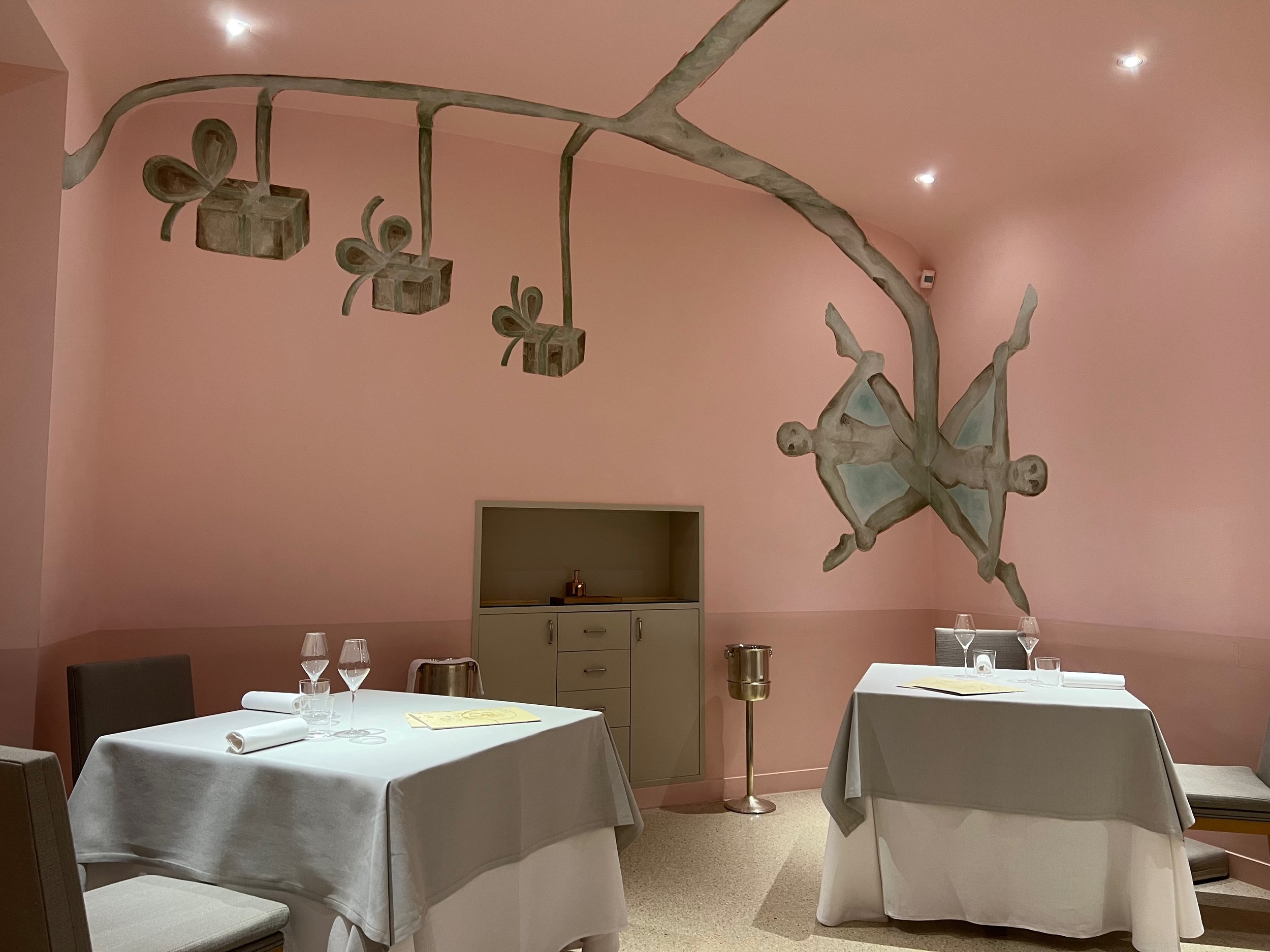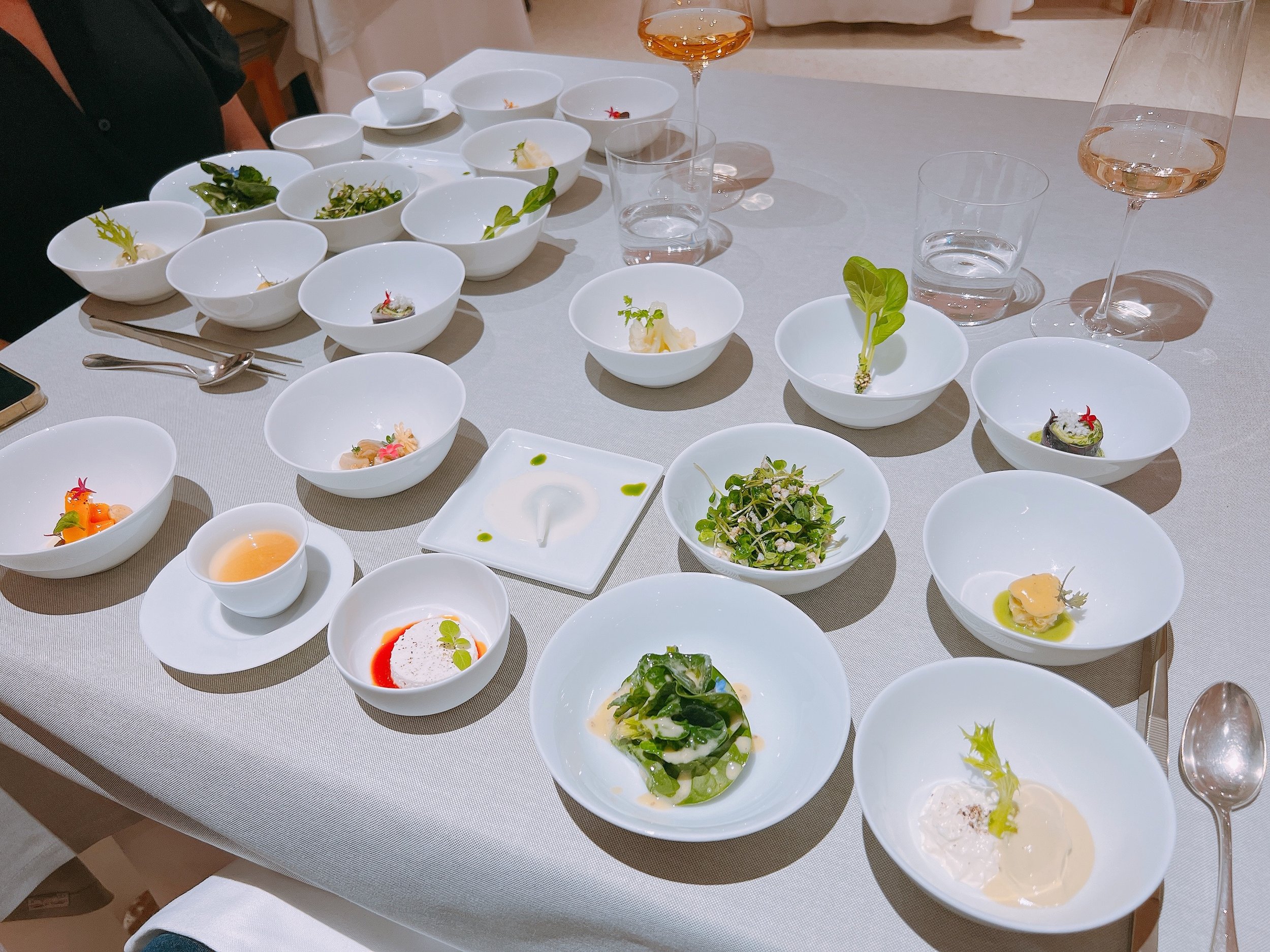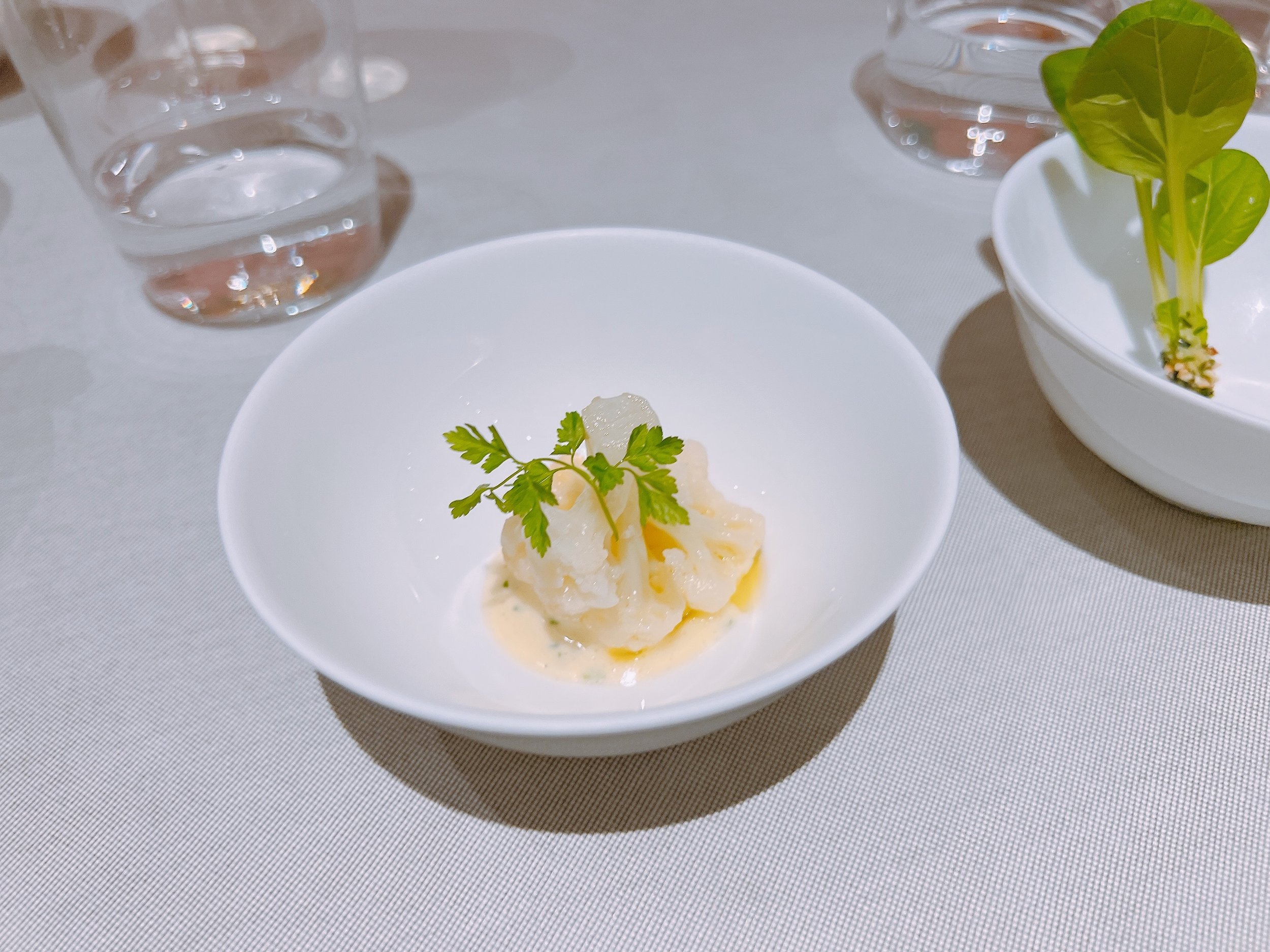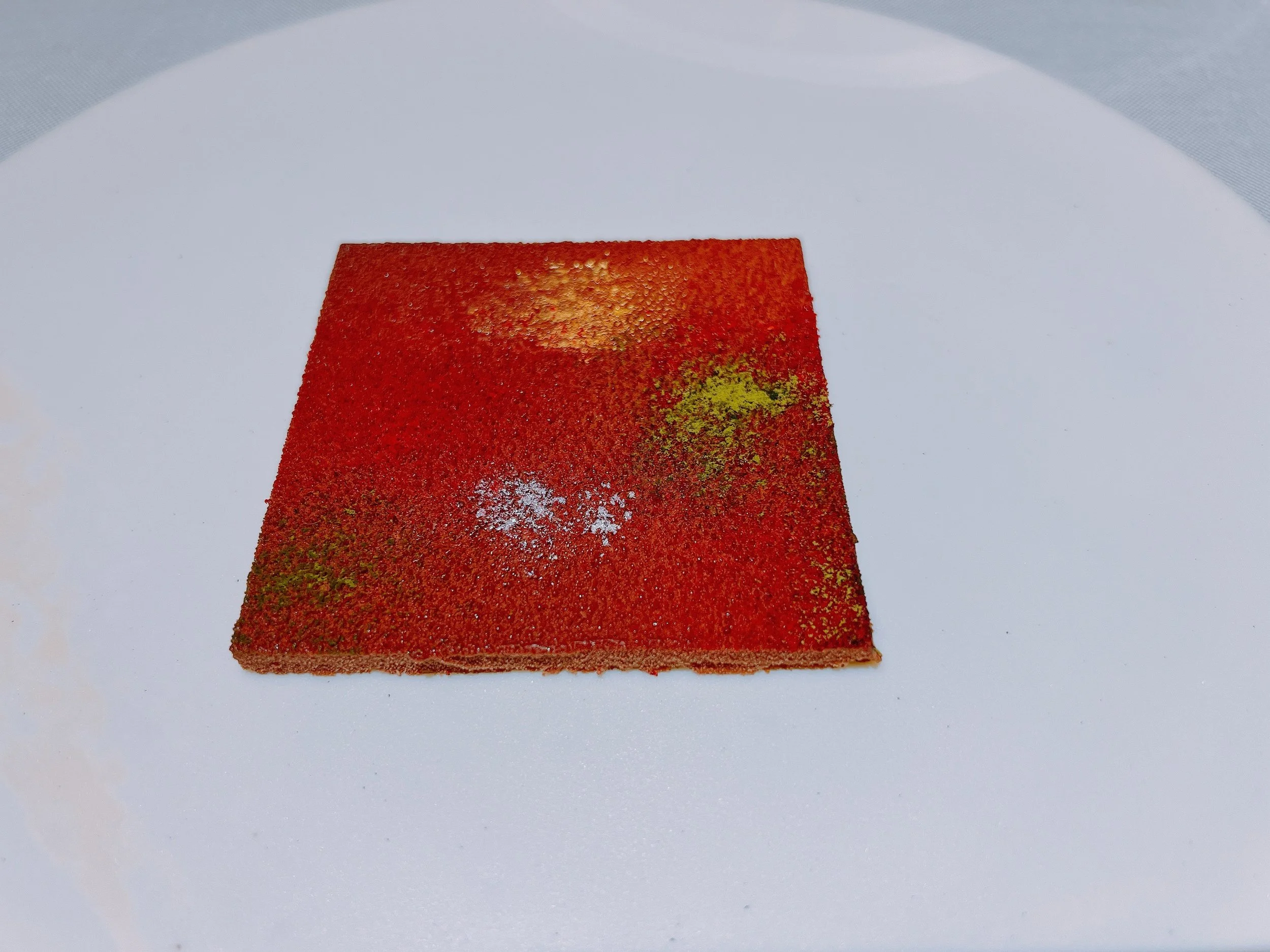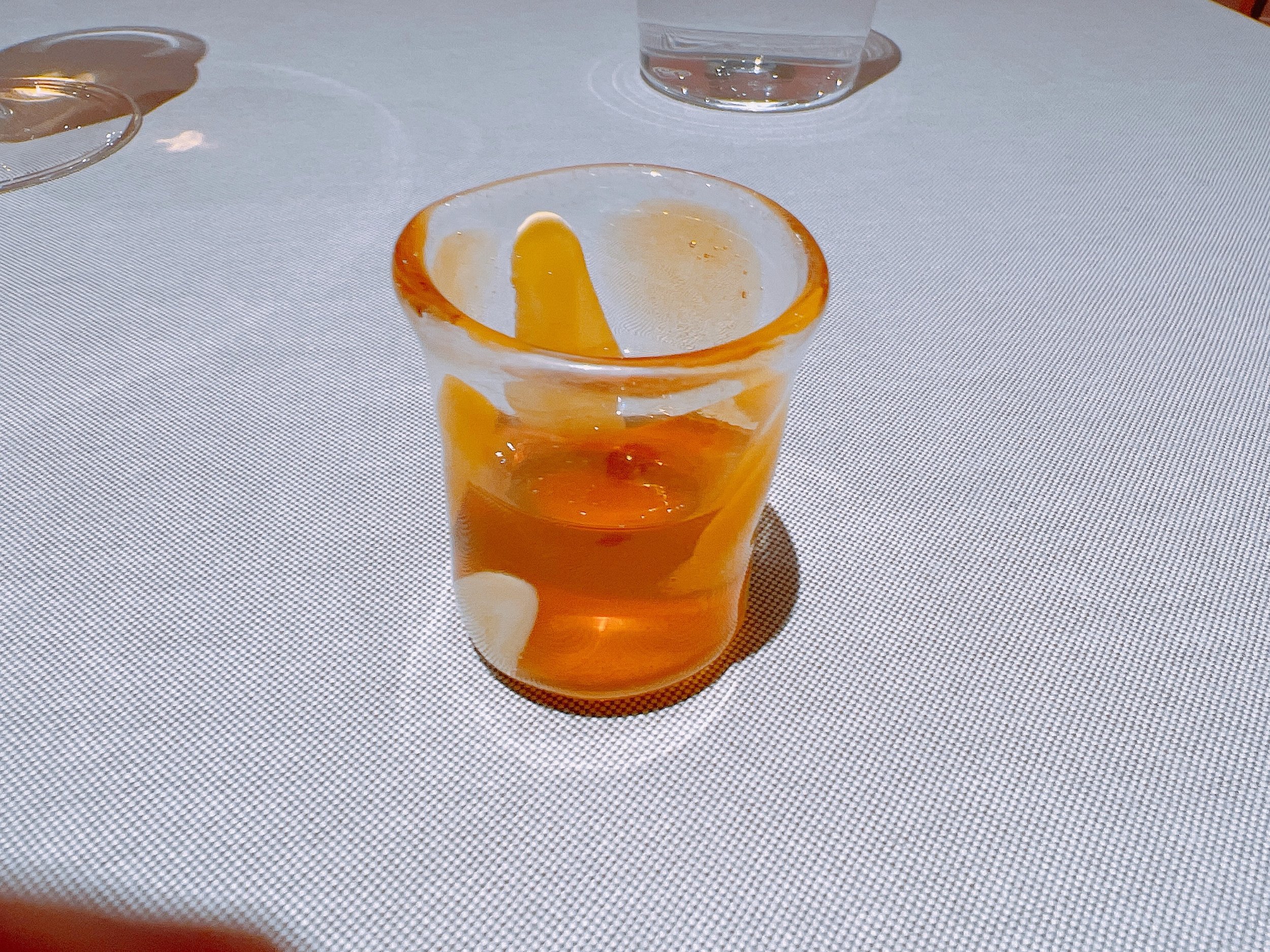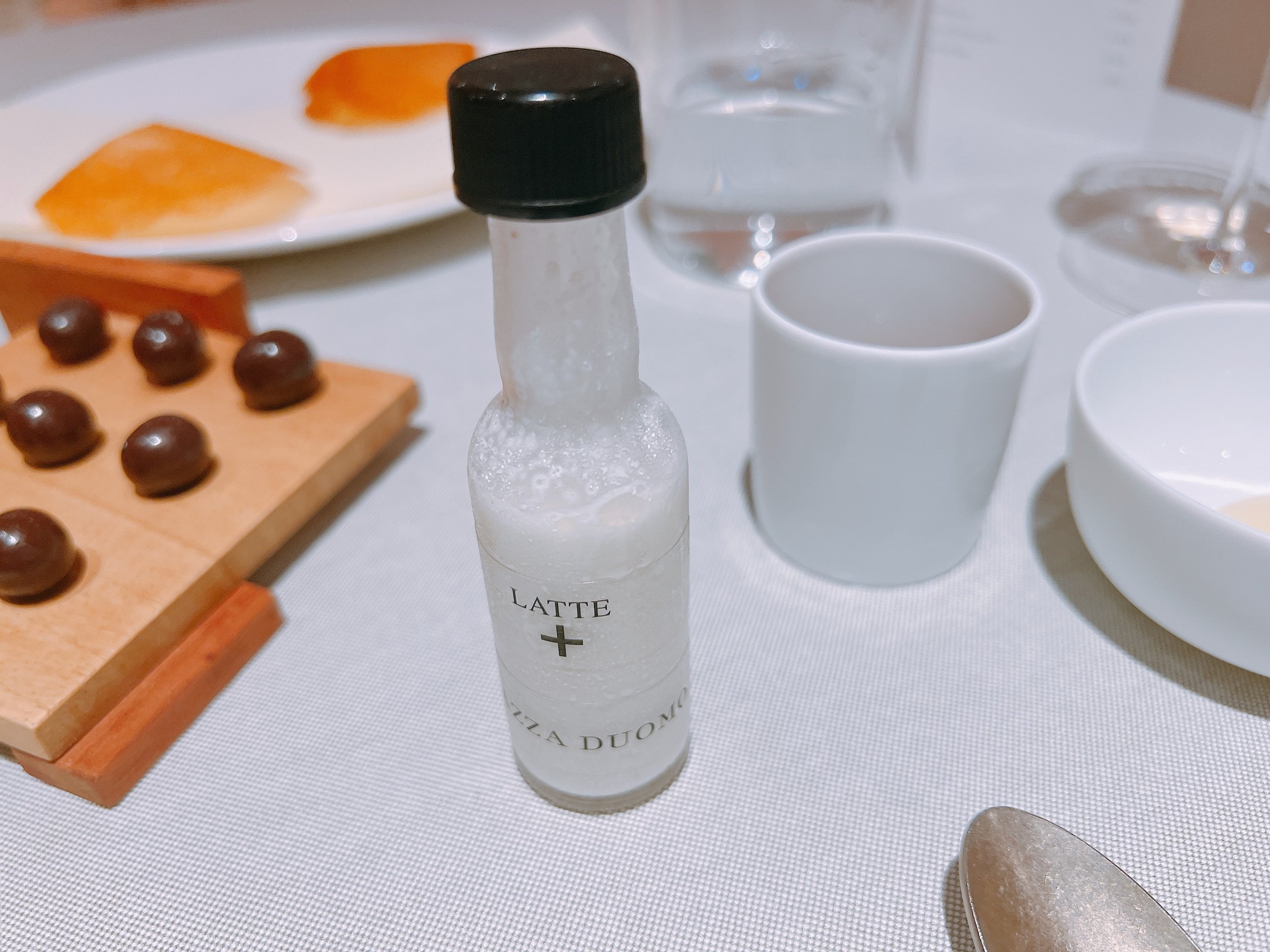Piazza Duomo - Alba
Rating: 17/20
Where: Alba, Italy
When: Dinner for 2 on 24 September 2022
Cost per Person: Tasting menu 290 Euro, Wine Pairing 180-800 Euro
Accolades: 3 Michelin Stars, #19 on Top 50 Restaurants list (2022)
Why: Seasonal modern Italian cuisine with some Japanese influences; a staggering variety of dishes; educational wine pairing
Piazza Duomo is named after its location - right on Alba's town square in front of the city’s cathedral, the Duomo di Alba. That doesn't mean that the restaurant is particularly easy to find, its entrance is on a small side street, and the restaurant itself is on the second floor with good views of the Duomo. On the same floor, the restaurant owns four guest rooms. They are not exactly cheap by Alba hotel standards, but definitely convenient for stumbling back to after a long dinner.
The restaurant's decor is light-colored, the walls in our room were pink with a painting that spanned the walls and ceiling. There were six tables in our dining room, but there was another room with at least a couple more tables.
Piazza Duomo offered two menus: a traditional seasonal tasting menu, and a menu paired exclusively with Barolo wines. During Alba's famous white truffle season (October and November), the restaurant also offers a truffle tasting menu. While the overall menu had to chosen at reservation time, there were still some additional courses that could be ordered at the restaurant: its famous salad, a truffle course, a cheese course, and so on. The Barolo menu included a fixed wine pairing, but for the traditional menu, there were three pairing on offer: a pure Piedmontese pairing, a "regular" wine pairing, and a "reserve" wine pairing. We went for the traditional tasting menu with the Piedmontese wine pairing. The latter consisted of decent, but not mind-blowing wines, but it was worth the price of admission just for the detailed and educational introductions by the sommelier. This was the only region-focused wine pairing I’ve seen in Italy’s three-star restaurants, and as such went the most in depth on the different expressions of locally grown grapes. Four white wines and three reds wines showed a wide variety.
Our dinner started with a mind-boggling number of individual dishes. First round: the amuse bouches. We were served seven of them simultaneously - actually eight since my dining companion (my sister), had expressed a dislike of foie gras. We were then free to eat these small bites in any order, as long as we started with the only warm dish, a fried ravioli. Filled with cheese, this ravioli was ok, but felt a bit too fatty and fried 15.
Two "olives" were actually made from minced langoustine (black olive) and minced veal (green olive). Thanks to being doused with olive oil, they really did taste of olives - lovely. I preferred the langoustine, but both were very good 17. A serving of foie gras incorporated some nice crunchy bits (I didn't catch what they were - all seven dishes were introduced at a break-neck speed) and was topped by a grapefruit and ginger foam. Decent, but the bitter-sweet grapefruit overwhelmed the taste of the foie gras 15. The non-foie-gras replacement was a turnip aspic, strangely without much of a turnip flavor. This was a light, slightly bitter dish 14. Tastier was a Parmesan cream wafer, the wafer a bit too soft, but overall nicely cheesy 15. A Parmesan chip with dollops of cream on top was also un-crackerly soft. Maybe that was the best way to stop it from breaking when taking a bite, but the result was just as mealy as the preceding wafer. The cream on top was excellent though, and the decorative herbs also added nice flavors 16. A fried tapioca leaf colored with spinach and topped with black garlic was not very crunchy, either 15. A pillow cracker filled with trout and topped with a furikake jelly was very tasty thanks to the great fish, but the pillow itself was again too soft 16. Finally, a chip with liver pate (I didn't try the non-liver alternative) had barely any liver taste and the chip was very mealy 13. There was an unfortunate trend in the making here: everything that should have been crunchy was soft and mealy instead. Whether this was intentional for some unknown reason, or because the dishes were prepared way ahead of time, I don't know.
Just when we thought that seven dishes were a lot to serve together, we received our first course, comprising twelve (!) individual plates. I have to assume that the kitchen wanted to show its wide range, and in fact the dishes varied from the superb to the unimpressive.
Seeing so many preparations at the same time reminded me of AM par Alexandre Mazzia, where the flavors of the dishes were so all over the place that they caused a sensory whiplash. Thankfully that was not the case here. Eating the dishes in the order they were presented led to a gentle progression and a good experience overall.
Our first stop was the only prescribed one (since it was melting): an endive sorbet with burrata cheese. The sorbet was lovely, not bitter at all, and the burrata delicious as well with a surprisingly chunky texture 18. A Brussels sprout sat in a sauce of broccoli and mustard - lovely with a spicy kick 18. Next, red and green cabbages topped with horseradish shavings and a sauce made from salad leaves (I think) were great as well, exhibiting strong flavors 18. Spinach served with a Dijon mustard dressing tasted fresh and the sauce was excellent 17. We then ate sprouts with ingredients that I didn't catch: possibly popped grains, possibly goat cheese, and possibly green salad puree. This was a good dish, but (compared to the previous bites) somewhat less focused thanks to having so many ingredients present 16. A tiny bok choy with furikake was amazing: spicy from the leaves, and with an almost fishy taste at the root (maybe from the seasoning) 19. Goat ricotta with a tomato sauce was a letdown - the cheese had little taste, and the sauce was unimpressive 13. An herb “ravioli” was really a sheet of white jelly draped over a ball of aromatic herbs. This dish had a strong, delicious herb flavor with a bit of cream from the jelly - very good 18. A small piece of cauliflower was served with a miso-based mayonnaise - a lovely sauce and a perfect consistency for the cauliflower: not too soft and not too raw 18. Creme caramel with miso was an odd dish: sweeter than the other dishes, but still quite savory. I found the miso a bit cloying and there was nothing in the dish to offset it, all the ingredients were a bit too similar 14. More miso in the next dish: foraged mushrooms were served with miso and potato chips. This dish was sour, almost mustardy, which was refreshing after the preceding heavy creme caramel 17. Finally, we had a marinated pumpkin that was served with a hazelnut (the latter a Piedmontese specialty). The nut was great, and the pumpkin not too overpowering in flavor, however overall this dish felt a tad too sweet 15. The whole course probably averages out to 17 or so, but clearly there is a wide variety, and I imagine there is something to everyone’s liking.
After so many dishes in a single course, our next course was in some sense the reverse - a highly complex single serving. Piazza Duomo's signature dish is the "Salad 21..31..41..51", the numbers referring to the number of different herbs, leaves and vegetables that make up the salad. Originally the number of ingredients was restricted to the ones listed in the name - varying by the season -, but today it has gone far beyond that. Our dish had a total of 85 ingredients out of about 120 possible ones, handily printed on a special menu card (see below). The salad was served with a sauce of vinegar and grape seed oil, but that sauce was placed at the bottom of the dish, so that the ingredients on the top of the salad were not touched by it. That was intentional since those ingredients had the most innate flavor: spicy, savory, sweet - an astonishing range. The salad also featured some Japanese touches: crackers, seaweed, and a bowl of dashi placed underneath the dish to collect the remnants of the sauce. Overall, this was a tour de force, with lots of stuff going on, and lots to experience - the herbs exhibited an astonishing variety of flavors. Just when we thought while eating this dish that the sauce was actually unnecessary, we finally reached it, and it turned out to be excellent as well, combining with the less flavorful salad leaves at the bottom of the bowl. The dashi was not as good (i.e. not as flavorful) as a really good one in Japan would be, but it was an elegant way to end the dish. All in all, very enjoyable, and less "work" to eat than a similar dish at Alléno Paris au Pavillon Ledoyen. The paired lemon and rose soda played well off the more spicy parts of the salad. Deservedly a signature dish, and a supplemental course ordered by most tables 19.
Next came a dish of uni, tomatoes, a pecorino cheese sauce and a seawater jelly that was colored with burnt spring onions. On separate plates we received a furikake crisp and an almond and coffee sorbet. A bit of an odd combination - I didn't really understand why these were all part of the same course. Also, we were slowly catching on to the fact that the kitchen really loved jellies, ideally circle-shaped and draped over dishes. These jellies weren’t bad by any means, but they became repetitive after a while.
This sea urchin dish was surprisingly light - I wasn't able to taste the uni at all, and the tomato only faintly; the jelly was almost taste-free as well. Not a success 14. The furikake crisp on the other hand was excellent: a combination of sweet and savory that was slightly chewy 19. The almond sorbet had too more almond liquor for my taste, but was otherwise good 17.
The next course was again split into several dishes, four to be exact, and their relationship was more obvious this time: all of them were based on beets. Beet tartare was covered by (drumroll) a disc of beet jelly. The tartare tasted a bit mayonnaisey, but was otherwise good 17. A beet-colored spongy sandwich was filled with herring cream and caviar. A pretty heavy dish thanks to the cream, it had only a subtle fish flavor, and the caviar was barely noticeable 16. A borscht made from veal and pork stock was decorated with a dollop of sour cream and raw spring onions. A nice silky soup, and the spring onion was a nice textural addition - I only wish there had been more of it. But tastewise, this was pretty mellow compared to other borschts I've had 16 (my sister was more enthused and would have given this an 18). Finally, a cup of clear borscht broth was even lighter in taste 15 (my sister would have given a disappointed 12).
Between courses, we were served some breads: breadsticks, a sourdough bread and a bread made from hazelnuts. The breadsticks seemed a bit stale (and again mealy), the hazelnut bread mealy and crumbly, the sourdough just basic. Not much to get excited about 13.
Our next course consisted of just a single plate. Roasted cod was served with shallots, porcini mushrooms, a mushroom sauce and the seemingly inevitable jelly, this time made from mushroom broth. Nitpicking about the jelly aside, this dish had an excellent mushroom flavor throughout, the sauce was creamy but still light, and worked perfectly with the amazing fish 19 (20 from my sister).
It was fun while it lasted, but we were back to three dishes for the next course. Charred squid was sliced very thinly and served with yuzu and chili peppers. The spiciness was lovely here, and the squid was very silky - it almost melted in the mouth 19. A different plate had a chard leaf draped over black olives - simple and good, but other than the color black there was little relationship to the squid 18. For the last dish, the connection was much clearer: copious amounts of squid ink blackened a lovely, savory polenta. The polenta also had some texture from pieces of lemon, as well as from something else that we didn't catch. Very nice 18.
Next came another course that we had ordered in addition to the tasting menu: the "truffle dish". A small amount of white Alba truffles were shaved over a potato mousse that was served with lapsong tea and a quail egg. The potato cream was excellent by itself, but the other ingredients (tea, egg, truffles) were very subtle and hard to notice 18.
The following risotto was laced with liver and dusted with a chocolate powder. The rice was perfectly al dente, and the liver and chocolate made for a good savory/sweet combination. I liked this dish, but didn't love it 17 (my sister was more bearish on this one, 16).
Final savory course: lamb. Several small pieces of lamb were covered with parsley, and served with black cabbage and a reduction of lamb jus. A great lamb (although not as good as the previous night's) and a great sauce; the cabbage was very nice as well 18.
We added the optional cheese course: a castelmagno cheese paired with a 2013 Moscato d'Asti. The (unusually for a Moscato) aged wine was excellent, but the cheese was crumbly and pretty light in flavor. I would have preferred more funk 16.
The main dessert came in three dishes. First, a square of hazelnut caramel looked pretty, and was light and tasty 18. A half-moon cracker filled with white chocolate and amaretti was nicely crispy but otherwise not too exciting 16. Finally, a glass of amaretto and almond juice was surprisingly good, neither too almondy nor too strongly alcoholic 17.
Eight petit fours served - of course - simultaneously concluded our dinner. Crispy crepes were light and tasty 17. A Piedmontese hazelnut cake was like a childhood memory made real, this was close to my favorite kind of cake - yum 18. We were also served a bunch of red grapes. These were not prepared at all (not even frozen...), so giving a rating seems silly. Hazelnuts covered in chocolate were a bit of a letdown: they were very tart thanks to the dark chocolate, and tasted very little of hazelnuts 15. A sandwich filled with stracciatella cream was very light in taste 14. A lemon and limoncello bite was light as well, and more sour than sweet 15. A black tea jelly was topped by a piece of lemon; this dish tasted pretty much of nothing, and only demonstrated that the kitchen was indeed capable of using gelatin to produce shapes other than flat discs 14. And finally, a tiny bottle contained a drink made from double-cream milk, muscato, grappa and vanilla. The drink tasted a bit like Baileys poured over (melted) vanilla ice cream. Not a bad, but not mind-blowing either 15.
Overall: This was a dinner that featured an astonishing number of dishes - almost 50 by my count. But the pacing was just right: the dinner took over 4 1/2 hours and didn't feel rushed. The kitchen used seasonal ingredients to great effect, not least in its deservedly famous salad. There were also some interesting Japanese influences in the cooking. Unfortunately, mealy textures in bakery items, and an overuse of gelatin wore out their welcomes quickly. With such a huge number of dishes, it's almost no surprise that some succeeded and some failed. Still, I'm intrigued enough to come back sometime to try the Barolo and the Truffle tasting menus 17.
